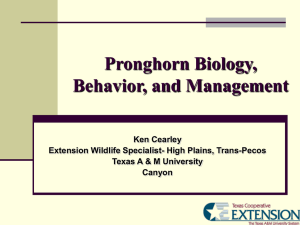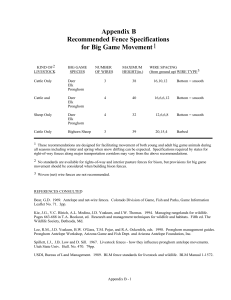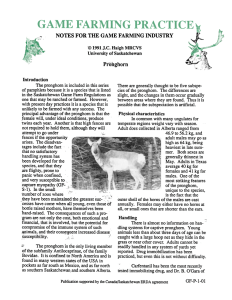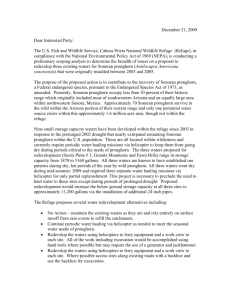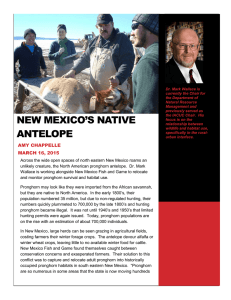Antilocapra Americana: Pronghorn TAXONOMY HABITAT
advertisement
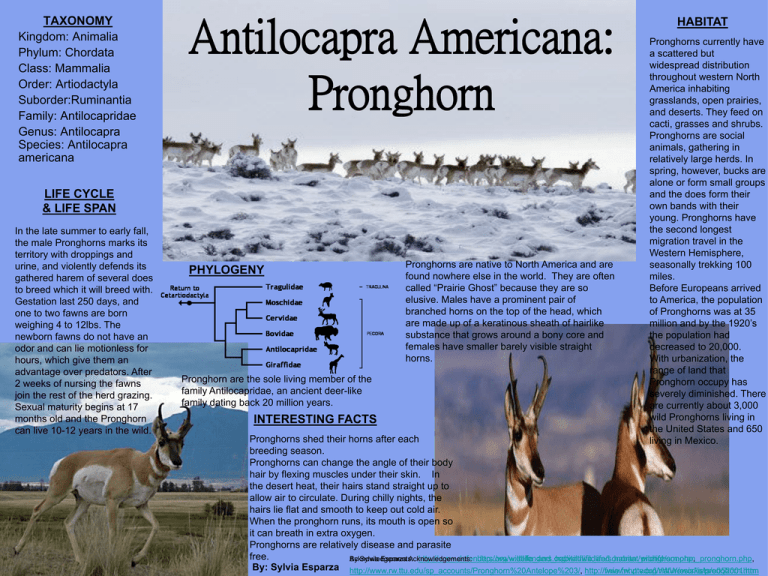
TAXONOMY Kingdom: Animalia Phylum: Chordata Class: Mammalia Order: Artiodactyla Suborder:Ruminantia Family: Antilocapridae Genus: Antilocapra Species: Antilocapra americana Antilocapra Americana: Pronghorn LIFE CYCLE & LIFE SPAN In the late summer to early fall, the male Pronghorns marks its territory with droppings and urine, and violently defends its gathered harem of several does to breed which it will breed with. Gestation last 250 days, and one to two fawns are born weighing 4 to 12lbs. The newborn fawns do not have an odor and can lie motionless for hours, which give them an advantage over predators. After 2 weeks of nursing the fawns join the rest of the herd grazing. Sexual maturity begins at 17 months old and the Pronghorn can live 10-12 years in the wild. PHYLOGENY Pronghorn are the sole living member of the family Antilocapridae, an ancient deer-like family dating back 20 million years. INTERESTING FACTS Pronghorns are native to North America and are found nowhere else in the world. They are often called “Prairie Ghost” because they are so elusive. Males have a prominent pair of branched horns on the top of the head, which are made up of a keratinous sheath of hairlike substance that grows around a bony core and females have smaller barely visible straight horns. HABITAT Pronghorns currently have a scattered but widespread distribution throughout western North America inhabiting grasslands, open prairies, and deserts. They feed on cacti, grasses and shrubs. Pronghorns are social animals, gathering in relatively large herds. In spring, however, bucks are alone or form small groups and the does form their own bands with their young. Pronghorns have the second longest migration travel in the Western Hemisphere, seasonally trekking 100 miles. Before Europeans arrived to America, the population of Pronghorns was at 35 million and by the 1920’s the population had decreased to 20,000. With urbanization, the range of land that Pronghorn occupy has severely diminished. There are currently about 3,000 wild Pronghorns living in the United States and 650 living in Mexico. Pronghorns shed their horns after each breeding season. Pronghorns can change the angle of their body hair by flexing muscles under their skin. In the desert heat, their hairs stand straight up to allow air to circulate. During chilly nights, the hairs lie flat and smooth to keep out cold air. When the pronghorn runs, its mouth is open so it can breath in extra oxygen. Pronghorns are relatively disease and parasite free. Acknowledgements: By Sylvia Esparza Acknowledgements: http://www.defenders.org/wildlife_and_habitat/wildlife/sonoran_pronghorn.php, http://www.defenders.org/wildlife_and_habitat/wildlife/sonoran_pronghorn.php, By: Sylvia Esparza http://www.rw.ttu.edu/sp_accounts/Pronghorn%20Antelope%203/, http://fwie.fw.vt.edu/WWW/esis/lists/e052001.htm http://www.nhptv.org/natureworks/pronghorn.htm
